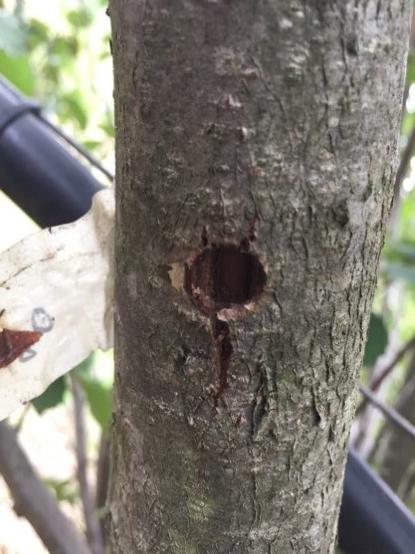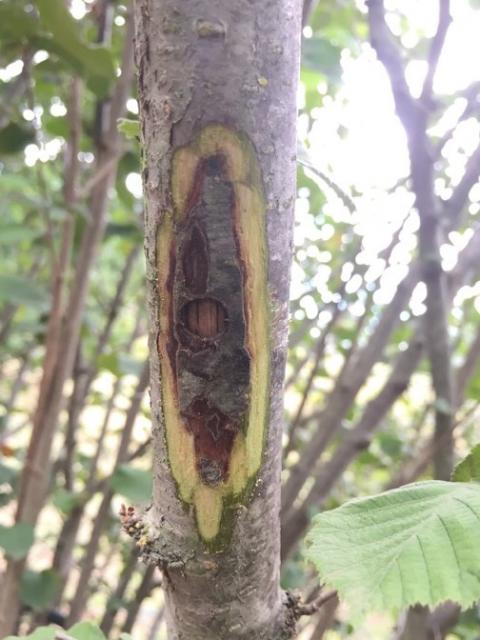Fungi important in disease on hazelnut trees
While visiting orchards as part of this project we observed that many have trees that are looking unhealthy and show disease symptoms, or have died. The number of unhealthy looking trees varies between orchards, from very few to a high percentage of trees. Unhealthy trees typically showed twig and branch dieback, distorted or under-developed leaves, or poor development compared to the general orchard. Some of the “unhealthy” symptoms are due to genetic variability in the seed source used to establish the trees, these trees typically display as “runts”. However, many of the symptoms we see are likely produced by pathogenic fungi. The purpose of this study was, therefore, to identify the fungi that cause disease.
A number of potential fungal pathogens were isolated from diseased or unhealthy looking oak and hazel truffle inoculated trees planted in orchards in Australia. Some of these fungi are well-known plant pathogens, such as Neofusicoccum, also known as Botryosphaeria, and Phytophthora cinnamomi. Neofusicoccum causes a dieback, called Botryosphaeria dieback, in a variety of plant species and Phytophthora root and collar rot is a serious disease causing mortality, especially under waterlogged conditions. A number of fungal species were also isolated which are not known as pathogens in oaks or hazels. This is partly because traditionally oaks (Quercus ilex and Q. robur) are understudied for their pathogens as they are not commercially cultivated, other than for truffle production. However, these fungi are known as pathogens in other tree species and therefore, warranted testing on truffle hosts.
To test the pathogenicity of these fungal species, an inoculation trial was established on 15-year-old Corylus avellana (hazel) trees. A trial on oaks is underway but unfortunately results are not available yet. The inoculation process involves growing the fungi on agar in the laboratory, then inserting an agar disc of each fungal species into a hazel branch. This is replicated over at least 10 trees for each fungus. A control treatment was included, where only agar but no fungus was inoculated. If the tested fungus is a pathogen, a lesion will develop on the branch. The more aggressive the pathogen, the larger the lesion. After two months, the length of the lesion produced is measured. Figure 1 shows the results of the inoculation trial in graphic form.


Not surprisingly, Neofusicoccum and Phytophthora caused the biggest lesions, confirming their role as pathogens. A number of other fungal species also caused significant lesions. These fungi include Diaporthe species, Illyonectria, Paraconiothyrium and Fusarium.
Diaporthe is interesting as it may also be found in healthy trees. This suggests it is endophytic, meaning it can live within the plant without causing disease symptoms, but it may associate with stem cankers. This means that it falls into a class of pathogens that are very difficult to control, as it may form part of the tree’s microbiome, but only causes disease when the tree is under stress. Stress can be caused by a number of factors such as over- or under-watering, chemical damage/burn or physical damage e.g. from pruning, hail and/or wind. Recent observations suggest that other pathogens may also provide the necessary stress factor required for some endophytic fungi to cause disease. Other such pathogens in truffle orchards may include powdery mildew in heavily infected orchards.
Illyonectria is an important pathogen on nursery tree seedlings and warrants further investigation into its role in truffle host tree disease, given that it produced relatively large lesions in the inoculation trial.
Fusarium oxysporum was isolated from a waterlogged, wilting Q. robur. It is therefore not particularly surprising that it did not cause disease in healthy hazel trees. Further testing on Q. robur will shed more light on this potential pathogen as it falls into a class of very important, but host specific wilt pathogens causing devastating diseases such as panama wilt disease of banana.
In conclusion, the disease situation in truffle orchards in most cases is relatively benign, with only some trees showing disease symptoms or death. In orchards with extensive disease presence, there are usually stress factors that induce tree decline by endophytic fungi. Growers are encouraged to monitor any tree disease in their orchard and take steps to minimise tree stress.
